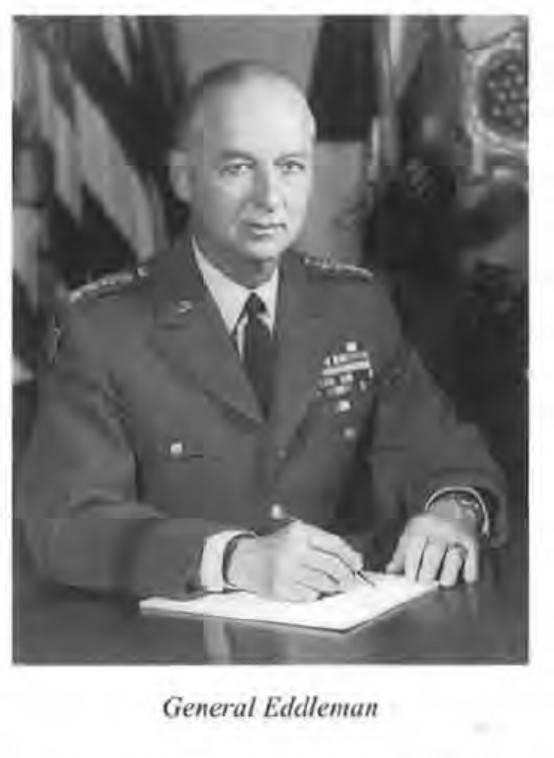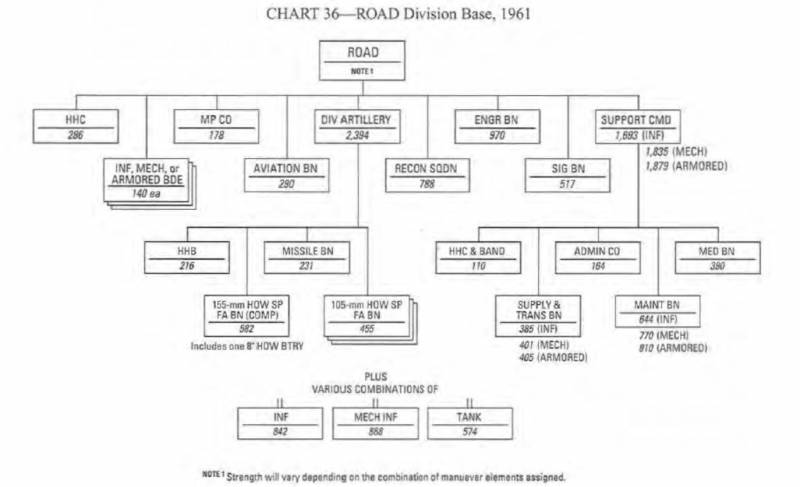Finished developing a ROAD plan in the USA. Objective reorganization of army divisions
Introduction of battalions instead of battle groups
The development of the organizational structure of the divisions of the US Army in 1960-1980 years. Answering to Addleman's wishes, the developers of the ROAD plan determined that the infantry battalion was more suitable than the combat group as the main building block of the infantry division. The advantages of the battalion included better management, simpler training procedures, a greater variety of tactics on the battlefield, and more career opportunities for infantry officers. In the battle group, the effective command level of the commander was too great. He had so many diverse units for supervision (infantry, artillery, engineering units, medical, communications, reconnaissance, logistics and maintenance) that it was difficult for him to manage the detachment.

Returning to the infantry battalion will simplify command and control, logistics and maintenance, and training. Given the need to disperse on the battlefield, the study noted that 20 per cent of the combat strength of the pentomic infantry division accounted for each combat group. The loss of one battle group in battle would be significant. With nine infantry battalions, the new division will lose only 11 percent of its combat power if one of its battalions is hit by a nuclear strike. In addition, many situations in combat required a greater variety of answers than the combat group could easily have given. Some tasks were too big for a company, but too small for a battle group; other tasks require strength more than one battle group, but less than two. Smaller infantry battalions seemed to meet these needs. Finally, the battle group provided little opportunity for infantry officers to gain command experience. If the battle group is maintained, only 5 percent of the army lieutenant colonels will receive command assignments, and only the 4 percent of the majors will serve as deputy commander. After weighing all these aspects, the planners recommended that the infantry battalions replace the battle groups.
In an effort to ensure maximum uniformity, simplicity and flexibility, shunting battalions were as similar as possible in accordance with their individual functions. Each infantry, mechanized infantry and tank The battalions consisted of a headquarters, three line companies, as well as a headquarters and a serving company. The similarities between the shunting battalions extended to reconnaissance platoons, which were the same in all battalions, and to platoons in reconnaissance squadrons. Given these battalions, companies and platoons can be used to create battle groups for specific operations with minimal differences. Using the latest weapons, all infantry battalions and reconnaissance squadrons had two low-power Davy Crockett nuclear above-caliber ammunition, which were considered a “salvage strike” for ROAD divisions. Infantry and mechanized infantry battalions also had a new ENgin-Teleguide Anti-Char (ENTAC) rocket, a French-developed anti-tank weapon.
The plan's developers assumed that if there is a unified division base and different numbers and types of battalions for shunting, the divisions can be adapted in three ways. The first, “strategic level”, will give the army headquarters the opportunity to create combat groups to accomplish the task in the interests of the operation; the second, “internal tactical level,” allowed the division commander to create battle groups for his own tasks; and the third, “external tactical level,” allowed the commanders of an army or corps to change divisions, depending on the circumstances. In the past, units were adapted in all three ways, but the ROAD plan facilitated this adaptation at all levels.
Completion of development
4 April 1961 officers of the Continental Command Army and Army Headquarters introduced Decker with the concept, and he approved it nine days later. However, he told Powell that the divisions should have been mainly fixed, because the army did not have the resources to maintain the reserve divisional battalions for the division within or between theaters. According to Decker, the interchangeable characteristics of the battalions were sufficient to ensure the organizational structure within and between divisions without retaining additional units. He asked Powell only to consider replacing the towed artillery with self-propelled artillery, including 155-mm howitzers and reorganizing the missile battalion, to include both Onest John and two 8-inch howitzers batteries. The number of vehicles in the infantry battalion also seemed excessive, and Decker wanted to reduce it whenever possible. The study provided only two Davy Crockett charges for each infantry battalion and reconnaissance squadron; Decker proposed adding a third one, making one available for each linear company or squad in these units. As a priority, Decker wanted the doctrine and educational literature to be quickly developed, especially for a company of support. The doctrine of the use of nuclear weapons remained unclear.
Over the course of several months, the Continental Army Command published draft tables for divisions under the ROAD plan - infantry, mechanized infantry. and armored divisions (3 chart). They switched to 105-mm towed howitzers in the infantry division and the 30-percent reduction in infantry battalion transport. The 155-mm / 8-inch howitzer battalion remained as planned, but a new missile battalion was developed, consisting of a headquarters and service unit and two Onest John batteries. In each infantry battalion and reconnaissance squadron there were three, rather than two, Davy Crockett charges.
HHC - headquarters and company staff services; MP CO - police company; MECH BDE - Mechanized Brigade; INF BDE - Infantry Brigade; ARMORED BDE - tank brigade; SV CMD - support command; Recon sqdn - reconnaissance squadron; Sig Bn - battalion of communications; Aviation Bn - Army Battalion aviation; ENGR BN - Engineering Battalion; DIV ARTILLERI - Division artillery (not division); 155mm HOW SP FA BN - 155mm self-propelled field artillery battalion (closer to the division in the SA); MISSLE Bn - missile battalion; TRAINS Bn (TRAINS) - battalion of transport support; MED BN - medical battalion; MAINT BN - maintenance battalion; ADMIN CO - curfew company
Considering this diagram, we can note that as a result of the development of the ROAD plan, the divisions of the United States received a United States Army Command, which remained with slight changes until the end of the Cold War. The changes concerned the number and types of the main battalions, the composition of the division’s artillery while maintaining the number of field artillery battalions, the expansion of the army aviation battalion to the brigade, but the idea of having 3-x brigade headquarters that did not have a permanent battalion and received them for a specific combat task remained until of our days.
To be continued ...
- Sergey Vasilenko
- vasilencoserg.livejournal.com
- Reorganization of the American divisions at the beginning of the 1960's. MOMAR-I and ROAD Plans

Information